
Inductees 2017
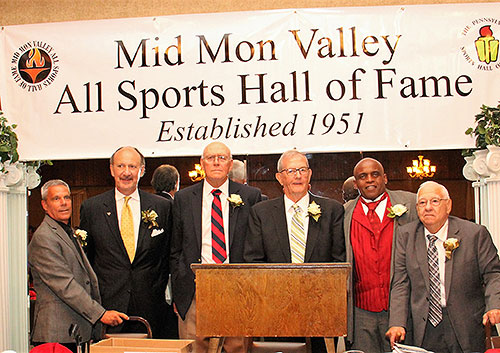
Meet the 2017 Mid Mon Valley All Sports Hall of Fame Inductees
Left to right are Coach Joe Salvino, Scott Nedrow, Daryle Ruby, Joe Margoneri, Phil Hughes, and Coach Don Bartolomucci
Don Bartolomucci
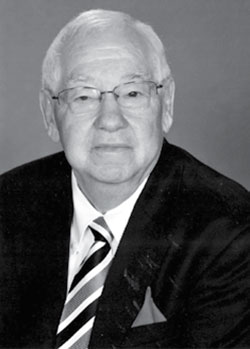
Don Bartolomucci was a football lifer. As a player football provided him with an education, and later a career in education and coaching.
Bartolomucci was a crackerjack running back on some fine Brownsville High School football teams in the 1950s. A four-year starter, he played on teams that posted records of 5-5 in 1952, and in his sophomore year in 1953, they posted a 6-4 mark and handed Uniontown its only loss. In 1954, they were 9-1. The lone blemish was a 19-7 loss to Duquesne. Even with one loss, Brownsville was accorded WPIAL championship status in some quarters. They were WPIAL champs as measured by Dr. Roger Saylor’s rankings. By his ratings system, the Brownies were WPIAL champs, even though they had lost to Duquesne.
In 1955, Bartolomucci’s senior campaign, the Brownies went 7-2-1. “In the four years that I started we never had a losing season,” Bartolomucci stated. “My brother, Frank, was a senior and I was freshman and I went to elementary school in Newell, and in eighth grade, I traveled up to the high school and played JV football and freshman football. Then in ninth grade, I was fortunate to go to camp and start with my brother. He was a right halfback and I was a fullback, and Howie Brashear was the left halfback.”
Bartolomucci earned All-Big Six honors in 1954 and 1955. “It was a big thing in the valley to be in the Big Six at that time,” Bartolomucci recalled. “Making the conference team was like making the WPIAL team for us back then. My sophomore year, I made honorable mention and we used to have the banquets at the Twin Coaches, and that was a big deal. My junior year, I was first team All-Big Six, and in 1955, my senior year, I tore up my knee and I didn’t get to play the whole season, so that year I made second team All-Big Six.”
When Bartolomucci graduated from Brownsville in 1956 he was coming off that knee injury and his participation in Washington County–Fayette County All-Star game was a big factor in getting a college football scholarship. He was a starter on the Fayette County All-Star squad that defeated the Washington County All-Stars, 14-6, in front of 5,000 fans in Connellsville.
“When I tore my knee up my senior year,” Bartolomucci explained. “I had some letters and offers, but I didn’t have anything concrete, so playing in that All-Star game was very, very important for me because I didn’t have any offers. When the game was over John Popovich, the coach at Waynesburg College came in the locker room and recruited a bunch of kids from the valley. There were four of us that were recruited to Waynesburg.
“Three of us started our freshman year, which was a pretty big honor. I starter four years, we didn’t win a lot of games, but we won a lot of fights. Bartolomucci played on Yellow Jacket squads that went 1-5-1 in 1956, 3-3-1 in 1957, 3-5-1 in 1958 and 1-6-2 in 1958. He garnered Little All-American Honorable Mention honors 1958 and 1959. He was selected as an All-District fullback. He had a big season in 1959 rushing for 808 yards. He played in the Gem Bowl All-Star game in 1959. The East downed the West in that game, 17-16. “The Gem Bowl was college players from the Big 10 and small colleges,” Bartolomucci said. “The head coach on the West squad was Ara Parseghian. I ended up playing for the West squad and I kicked an extra point in that game. It was a great experience playing for somebody like that.” Bartolomucci went to work for New York Life Insurance and worked for them from 1960 to 1965. He started his coaching career an assistant at Beth-Center High School in 1965.
“Bill Connors, who was a quarterback in high school when I played, got the head coaching job at Beth Center,” Bartolomucci said. “I gave him a call and asked him if I could help him out. But I didn’t have a teaching certificate. I was friends with Marion “Slugger” Klingensmith who took me to the Education Department in Harrisburg and I got an emergency certificate and I needed 13 or 14 extra hours. They hired me on an emergency certificate, that’s how I got into education. I got certification right away from California University and that’s how my career started.”
Bartolomucci served as a position coach at Beth-Center from 1965-70, defensive coach from 1970-78, head coach from 1979-1987, assistant coach in 1989 and was head coach again from 1990-94. “I was an assistant for Bill Connors for 14 years,” Bartolomucci offered. “Then I got the head job, in 1987, my assistant coach got killed in a tractor accident and I kind of lost interest, I was pretty broken up over it, so I resigned. It’s a good thing I did because in 1989 I had heart surgery. It worked out perfect for me. I became an assistant with Bobby Keys at Jefferson-Morgan; I wanted to see if I could handle it and come back. Then I re-applied at Beth-Center in 1990 and I coached there for five years.”
His record at Beth Center was 99-46-4 with trips to the WPIAL playoffs in 1982, 1986, 1991, 1992 and 1994. In 1982, 1986 and 1994 he won Century Conference championships. His 1986 squad made it to the WPIAL Class AA championship game and lost to Burrell, 3-0. “Beth-Center had great tradition,” Bertolomucci stated. “It started with Bill Connors and then through my tenure and Ed Woods had a great career there too. It was all about who you hired as coaches, I always hired people that I coached, so I didn’t have a problem selling them on the system. You have to have three things in coaching: administrative support, great assistants and you have to have great kids. I was lucky I had all three aspects.”
Bartolomucci retired from teaching in 1993, but continued to coach. He returned to Brownsville, taking over a program that was floundering with a record of 3-27 in the previous three seasons. Three years later in 1997, Brownsville was in the WPIAL Class AAA championship game at Three Rivers Stadium, falling to an outstanding West Allegheny team, 51-24. Brownsville also qualified for the playoffs in 1998, 1999 and 2000.
“I wanted to go home,” Bartolomucci said. “You have to be in the right place at the right time and they had some outstanding athletes coming up. We had an unbelievable group of athletes and I still have breakfast with some of those kids. It was a great group and we had a great run.”
Bartolomucci married the former Marjorie Kuklo in 1959 and they have three children, Don, Terri and Marc. Bartolomucci is retired and resides in Scenery Hill.
The overall coaching record for Bartolomucci is 147-82-4. He was honored as Coach of the Year in Washington County, the Century Conference and the Eastern Association of Interscholastic Football Officials. He was inducted into the Washington-Greene County Hall of Fame in 2010.
(Grateful acknowledgement to George Von Benko for this biography that appeared in the Herald-Standard December 26, 2016)
Phil Hughes
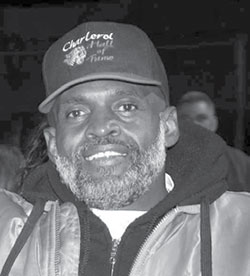
One of the greatest runners in the long history of Charleroi was Phil Hughes (Class of 1971), a rare 1,000 yard rusher, joining the likes of Lew Rawls who gained 1,019 yards in 1966.
Flashback to Hughes’ high school glory days as a three-year letterman in basketball, track, and football. He set two school records by high jumping 6’ 1” and by finishing the 100-yard in a sizzling 9.9 seconds. Hughes said he nearly “made it to the States, but I pulled a hamstring. I got beat three times in three years, once a year, by the same person, Norman Jones from Clairton and I ran a 4.3, 40 on cinders, once with bare feet—I was trying to show off,” he chuckled.
Still, football was understandably his favorite sport. The 6’ 1”, 185 pound Hughes rambled for 3,217 yards and scored 257 career points. He began flashing his talent as a mere sophomore, becoming the first Charleroi running back to gain over 1,000 yards (1,109).
Further accomplishments earned him All Big 10 status in his junior and senior seasons. In fact, as a junior his 1,211 yards rushing established a new school record. That record stood for decades until Darrell Harding eclipsed it. In his junior season, Hughes also led his conference in scoring with 93 points while turning in an incredible three games with 200+ yards rushing. Every time he lugged the football he churned out 5.9 yards.
Due to an injury, his senior yardage output slipped to 897 yards, which was still a stellar total and easily good enough to earn him first team All-State honors. Toss in the fact that he was a defensive star. His head coach, Rab Currie, once said, “He has some of the best moves I’ve seen for a high school kid.” He added, “When he’s hit, he gives it a second, third, and sometimes a fourth effort. I’ve seen him break as many as four tackles on his way to a touchdown.”
Hughes still recalls one rainy night game against Clairton in which he scored on a run and on a 37-yard field goal. He said, “The headline in the paper said HUGHES 9 CLAIRTON 0. But Monessen was our rival, and I never beat them, and that hurts me. They had signs up on the Charleroi –Monessen Bridge that I saw as I went to their stadium when I was a senior that said PHIL WHO? But my ankle got twisted against Brownsville before that, when I had three touchdowns in the first quarter. So I couldn’t play against Monessen, and the signs made me so upset that I couldn’t represent. And we only lost by about three points. If I was playing, we would have dominated them.”
Hughes received a full scholarship to Potomac State, a West Virginia junior college. West Virginia University coach Bobby Bowden had a great runner at the time, Jim Braxton, but Hughes said there was a chance that he would fill a Mountaineer void after he went to Potomac State. However, Hughes became discouraged there, where he said the team’s field “was like a cow pasture,” so he returned home. Hughes said he tried out for and impressed Hall of Fame coach George Allen who was coaching the Washington Redskins. Hughes was hopeful that he might take the roster spot left vacant when Charley Taylor was about to retire. Taylor changed his mind, though, so Hughes switched gears and played semipro ball for teams such as the Washington Generals and the Pittsburgh Wolf Pak who had former NFL quarterback “Jefferson Street” Joe Gilliam throwing to him.
According to Hughes, he also tried out for the Steelers at Three Rivers Stadium, but he was told by team official Dick Haley that despite his talent, the Steelers “had a dynasty going” at the time and had no room for him. Undaunted, Hughes played for Morgantown for $25 per game. Traveling there from the Valley three days a week for practices, he was playing for the love of the game, certainly not for the money.
Hughes is a member of the Charleroi Football Hall of Fame and the Charleroi All Sports Hall of Fame. A retired West Penn Power worker, Hughes is the father of one son, Marcus Allen Hughes—named after two uncles, not for the former NFL great. Hughes still resides in the Charleroi area, living in the house he grew up in, the very house where he began his football days, throwing the ball around in his yard.
“I still have all my same old friends I had when I was in high school. I’m happy.” Looking back, he says he is most proud of achieving what he did in sports for his hometown.
(Grateful acknowledgement to Wayne Stewart for this biography that appeared in the Herald Standard January 23, 2017)
Joe Margoneri
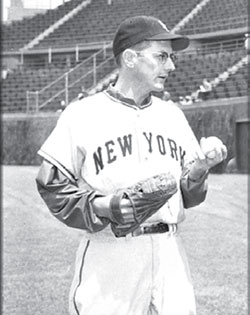
Smithton native Joe Margoneri was like a comet bursting on the major league baseball scene and then fading because of arm trouble.
The fireballing lefty honed his baseball skills on the sandlots in Western Pennsylvania.
“We didn’t have baseball at South Huntington Township High School,” Margoneri recalled. “I played sandlot baseball when I was like 16 or 17 years old with older players. We had town and patch teams like Herminie and Madison, just small coal mining towns. When I was older like 18 or 19 I worked for Walter King who owned coal mines and coke oven in Scottdale. I drive a truck from the coke ovens and he ran a team and I played for his team.” Margoneri was discovered by the New York Giants and King played a big part in his signing.
“Playing for King it was semi pro baseball,” Margoneri said. “I got about five bucks or ten bucks here and there. King called a scout for the New York Giants named Nick Shinkoff. I pitched a game on a Friday night and had a good evening and King came to me and said come over here a scout wants to see you pitch. I went up on Saturday morning and just threw on the side with a catcher. Shinkoff brought me back home and I signed a contract that day. I sat down with my mom and dad and he gave me two brand new baseballs and I signed a Class D contract for $200 a month.”
At age 20 he led the Wisconsin State League in wins (23) & strike outs (288) at Oshkosh. The 288 strikeouts set a new Wisconsin State League record. “The first year I set the strikeout record,” Margoneri stated. “The fastball was my bread and butter pitch. They didn’t have a radar gun, but I guess I was throwing in the mid 90’s. I had a lot of strikeouts; I threw mostly fastballs and tried to work on a curve and a change up.”
After posting a record of 23-4 at Oshkosh, Margoneri jumped to Class B Sunbury in the Interstate League. In 30 games, 28 starts he went 18-8 and recorded 212 strikeouts.
“I led the league in strikeouts at Sunbury and then the Army got a hold of me,” Margoneri said.
Margoneri was drafted into the Army during the Korean War.
He spent the next two seasons (1952-53) stationed at Brooke Medical Center in San Antonio, Texas. “I was fortunate, I stayed state-side. I played baseball down in San Antonio, Texas. It was what they called special service. They had football players, basketball players — all types of athletes down there in one section,” he said. His teammates included some big leaguers “Don Newcombe and Bobby Brown were down there. We played semi pro teams and the air bases down there around San Antonio. We were really good. Playing in the service kept me sharp.”
Margoneri returned to the Giants minor league system after his two years in the service and pitched Double A Nashville and Triple A Minneapolis. He was 14-10 for the Nashville Volunteers and 1-0 for the Minneapolis Millers. Margoneri led the Southern Association with 184 strikeouts.
Deciding to play winter ball Margoneri pitched for the Navegantes del Magallanes club of the Venezuelan Winter League, and was responsible for the only defeat suffered by the Puerto Rican Cangrejeros de Santurce champion team, 7–2, in the closing game of the 1955 Caribbean Series. Notably, Margoneri hurled a complete game against a powerful lineup that included future Hall of Famers Roberto Clemente and Willie Mays, as well as Harry Chiti, Buster Clarkson, George Crowe, Luis Olmo and Don Zimmer.
During this period the Giants signed him to a four-year contract.
Margoneri was on the Giants radar when he came to spring training in 1955. In the March 7, 1955 issue of the Long Island Star-Journal, Giants’ manager Leo Durocher raved about Margoneri’s potential. “I like everything about the kid, said Durocher. I like his attitude … his poise … his motion … and, above all, his fastball. He’s firing’ harder than the others because he’s ready. He pitched in one of those winter leagues.”
In 1955 Margoneri pitched for the Giants top farm club at Class AAA Minneapolis. He helped lead the team to the 1955 Junior World Series Championship, defeating the Rochester Red Wings of the International League in the best of a seven game series.
The nonstop pitching was starting to take a toll on Margoneri. He started to develop arm trouble. “That’s when my arm trouble started. I was throwing 150 pitches per game and became a bit wild,” he said.
Margoneri was 26 years old when he entered the majors in 1956 with the Giants, playing for them two years. His most productive season came in 1956, when he had a 6–6 record with a 3.93 earned run average in a pitching rotation that included Johnny Antonelli (20–13), Rubén Gómez (7–17), Al Worthington (7–14) and Jim Hearn (5–11). The next year he worked almost exclusively as a left-handed specialist out of the bullpen.
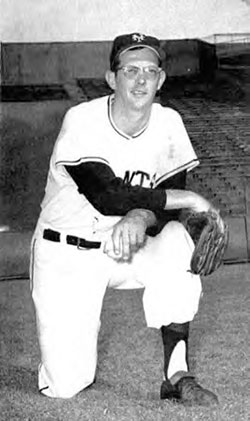 “When I was pitching in 1956 my arm was hurting,” Margoneri explained. “In 1957 it got worse, and they sent me to New York and they couldn’t do anything. I was so wild my early years that I would walk say 12 and have 14 strikeouts and two hits. I just blew my arm out.”
“When I was pitching in 1956 my arm was hurting,” Margoneri explained. “In 1957 it got worse, and they sent me to New York and they couldn’t do anything. I was so wild my early years that I would walk say 12 and have 14 strikeouts and two hits. I just blew my arm out.”
Margoneri pitched for Triple Phoenix in 1958, Double A San Antonio, Triple A Toronto and Triple A Toronto in 1959. He pitched 10 games with Monterey in the Mexican League and two games with Double A Indianapolis in 1960. Margoneri retired from baseball at the age of 30 after the 1960 season.
In a two-season major league career, Margoneri posted a 7–7 record with a 4.29 ERA in 36 pitching appearances, including 15 starts and three complete games, giving up 60 earned runs on 132 hits and 70 walks while striking out 67 in 126 innings of work. In nine minor league campaigns Margoneri compiled a record of 88-52.
After baseball, Margoneri worked from 1962 through 1991 in the corrugated paper business as a supervisor for the International Paper Company and the St. Regis Paper Company in Pittsburgh.
Margoneri was born January 13, 1930 and lives in West Newton with his wife of over 60 years Helen. They have five daughters and 13 grandchildren.
“I'm happy with my career we had a pretty good life,” Margoneri said. “It was tough on my wife back in those days moving around. Who knows what would have happened if I hadn’t hurt my arm. I see this Tommy John surgery and that’s where mine started in the elbow. Who knows they might have fixed me and I may have been able to throw 100 mph.”
(Grateful acknowledgement to George Von Benko for this biography that appeared in the Herald Standard April 18, 2016)
Scott Nedrow
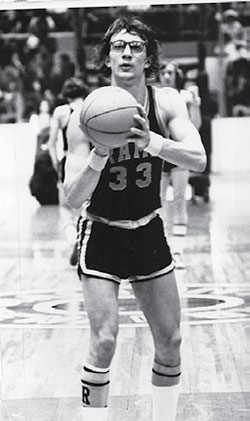
From tenth grade though college matriculation; Scott Nedrow proudly wore the blue and gold on the basketball court – first as a Ringgold standout, then in a Pitt Panther uniform.
In a way, his hoop days began when Nedrow transferred from Mon Valley Catholic after ninth grade (and after he then sat out half of his sophomore season at Ringgold). By the time he was a junior he was a starter for Coach Fran LaMendola.
The 1971-72 and 1972-73 seasons, the Ringgold Rams basketball team was stacked. In his junior season Nedrow was a starter along with running mate, sophomore Mel Boyd, Art Coleman, and two players later drafted by NBA teams, Ulice Payne and Tim Stokes. However they lost their first playoff game at the Civic Arena.
The following season, the starters were Nedrow, the senior class president, Boyd, Mike Brantley, Joe Montana and Payne.
“It was a magnificent year because no one expected us to do much because we didn’t go far the year before despite having Stokes and Coleman. And I believe this was one of the major factors that brought us together,” Nedrow said.
However, “We still had Boyd who was an All-American cross country runner at Pitt, Montana and Brantley, Ulice, and our sixth man Don Miller. That group of six all received Division I scholarships.”
“We had extraordinary athletes with a feel for the game and each other. On any given night, anyone could be the leading scorer. The whole team averaged between 11 and 16 points per game with Ulice and I being in upper range but everyone averaged in double figures”
The Rams defeated General Braddock in the WPIAL championship game and reached the final four in the state.
Nedrow said “The only disappointment was not winning the state championship. We lost to General Braddock in the State semis after beating them twice, once in regular season at home and again in WPIAL championship title game at the Arena. However, we redeemed ourselves in the State Consolation game by defeating the pretournament favorite and No. 1 ranked team Chester. We were ranked number two going in. Chester had lost to Reading and Stu Jackson, who later went on to Oregon and NBA fame”. Thus, you could say they had beaten the best and finished the season 29-2.
The Rams were, he said, rather tired going into the General Braddock game and the “flu bug was going around and that contributed to the loss, but we had a good run all through the playoffs.”
Nedrow said “The team really came together during the playoffs and it all started with a Section playoff win vs Belle Vernon. The game was played at Cal U in front of a packed crowd. It just happened to be my best game of my high school career going 11-for-12 from field and finishing with 25 points. But that victory really created the momentum for the team going into the WPIAL’s and the State Championship”
All in all, it was quite a season, but Nedrow said the chemistry of the group started the summer before. “Back then, they had a YMCA Tournament in Carrol Township and we won and again it was against Belle Vernon. We all started coming together and I was selected the MVP. Most importantly we started believing in each other”
Nedrow high school career ended being selected All Section first team, All State Honorable Mention and playing in the prestigious Roundball Classic contest held at the Civic Arena.
From there it was on to the University of Pittsburgh for Nedrow who said he had also considered Wake Forest, William & Mary, and Villanova. “Pitt was the right place for me, I felt comfortable with the guys and couldn’t understand why other local high school standouts would leave the Pittsburgh area and go elsewhere,” Nedrow said. “I used to watch guys like George Karl from Penn Hills go and play for North Carolina. I wanted to stay home and play in front of Pittsburgh fans. I almost ended up at Duquesne. We were close to signing with them, until the found a player in Georgia named Norm Nixon (later drafted and played for LA Lakers). It all worked out and we had fun competing against each other.”
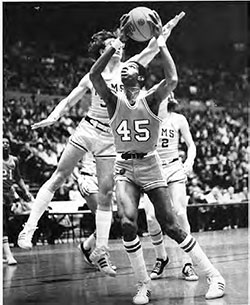 “In my freshman year, I didn’t play much, as we had a senior laden NCAA Elite Eight team. We lost to the eventual national champions, North Carolina State.” Nedrow said.
“In my freshman year, I didn’t play much, as we had a senior laden NCAA Elite Eight team. We lost to the eventual national champions, North Carolina State.” Nedrow said.
That team led by David Thompson, one of the greatest college basketball players ever and 7’2” Tom Burleson and point guard Monte Towe.
Redshirted the next year, Nedrow played extensively the following season as a shooting guard and began starting by midseason and wound up the second-leading scorer for Pitt, behind All American Larry Harris.
The next season his play time was reduced due to injury but still was Pitt’s third leading scorer for the year. In his senior season was elected co-captain along with Harris, and won the University’s Blue-Gold Award as the top scholar athlete and was nominated for the prestigious Rhodes Scholarship for study in Oxford University in England.
Nedrow has one son, William, a musician who lives in Los Angeles and graduated from Loyola Marymount University in L.A.
Scott’s job is quite different. He received his MBA from Emory University and then worked in the world of investments and finance for many years, working in many locations including New York City, Japan, Hong Kong, Singapore and London. Semi-retired now he runs his own small business consulting firm and after a long journey, he is now back home in the Mon Valley.
(Grateful acknowledgment to Wayne Stewart for this bio that appeared in the Herald Standard August 4, 2016)
Daryle Ruby
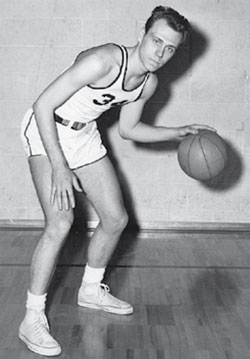
Mention outstanding basketball players in Mon Valley history and the name Daryle Alexander Ruby immediately comes to mind with longtime fans.
But there is much more to the life of the former Bellmar High School and University of Pittsburgh standout who has been a physical therapist for nearly 50 years.
“I was always interested in science and the human anatomy, how it functions and repairs itself – how the brain and spinal cord work, the circulatory system, muscle function, etc.,” said Ruby, a 1961 graduate of Bellmar High now living and working in Ocean City, Maryland. “I began to explore physical therapy as a career and decided that was a way to help people adapt and overcome physical, neurological and cardiovascular issues to maximize their potential and function for daily activities.”
Those keen interests led Ruby, who was president of his graduating class at Bellmar, to Pitt on an academic scholarship.
In addition to Pitt, he had received numerous offers from such Division I schools as Duquesne, Arizona State and Utah and NAIA schools throughout Pennsylvania, West Virginia and Ohio.
“I chose Pitt for several reasons,” Ruby recalled. “Coach (Bob) Timmons and his assistant, coach (Carl) Peterson, emphasized education when they were recruiting me to play basketball. They said the scholarship was academic and was for four years. Pitt also had a strong reputation with its graduate schools and was affiliated with the D.T. Watson School of Physical Therapy. In addition, Pitt’s on-campus students numbered 5,000 at that time, which gave it a small college atmosphere with university facilities.”
Ruby, the son of the late Stephen W. and Elizabeth Geraldine Parry Ruby of Belle Vernon, also was influenced by his father in deciding to continue his education and basketball career at Pitt.
“My Dad was a huge Pitt fan,” Ruby said. “He talked about the great teams of the 1920s ‘30s and ‘50s. He often mentioned Pitt’s Dream Backfield of the late 1930s – Curly Stebbins, Marshall Goldberg, Dick Cassiano and John Chickerneo. And he recalled the basketball teams coached by (Henry Clifford) Doc Carlson and such outstanding players as Paul Hyatt and Don Hennon. There was so much tradition there and I knew I wanted to be part of it.”
Buoyed by that inspiration and determined to meet the requirements of an academic scholarship – exceling in the classroom as well as in basketball – Ruby, a 6-4,190-pounder, carried strong credentials to Pitt.
He was a three-year starter in basketball at Bellmar and finished his 63-game varsity career with 995 points (15.2 ppg). He was named to the All-Section 5-A team as a senior with Willie Ross of Rostraver, Don Yates of Uniontown, Joey Russell of Donora and John Verkleeren of Charleroi. Collectively, that group scored 2,127 points, with Ross setting a hot pace with 606 as the section scoring leader. Ruby finished second with 501 and Yates was third at 481. Ruby also earned All-WPIAL and All-State recognition.
Ruby credits former coach Ken Clark with developing his basketball skills.
“Mr. Clark was my only basketball coach in junior high (Vernon) and high school,” Ruby recalled. “He was gentle but tough – very strict about the fundamentals of passing, dribbling, shooting, defense and ball handling. He always had a good game plan.”
Ruby’s older brother, Steve Ruby Jr., a 1955 graduate of Bellmar, where he was a basketball standout, also was a major factor in his development and success.
“Steve played basketball as a freshman at West Virginia University at later became a successful high school and college coach,” Ruby said. “Starting when I was in junior high school, he taught me individual offensive moves he learned at WVU and proper practice habits which improved my skills.”
True to his humble nature, Ruby is hesitant to talk about his prolific scoring at Bellmar.
“Other players assisted me,” he said. “I was fortunate to have some very talented teammates throughout my high school career – guys like Ron Coates, Carl Osborne, Ron Feher, Walter Lautsch, John Kasuda and John Daniels.”
Two games, however, do stand out.
“One of the best was breaking Sam Sergi’s single-game scoring mark of 31 when I had 33 against Brownsville,” Ruby said. “Sam was an outstanding athlete at Bellmar several years earlier; no question that he was one of the best ever in the Mon Valley.”
Ruby topped his own standard with a 35-point effort against Monessen on Friday, January 21, 1961 at the BHS gym.
“That remains in my mind because I knew (Monessen’s) Tony Romasco, Bill Malinchak and Eric Crabtree from playing ball in the summer,” he said. “Bellmar had never beaten Monessen, so we had a lot of incentive. When we came out of the locker room, the Monessen players were in the hallway and said they were going to beat us again. But we won 70-69 and that was a big night for us.” Ruby recalls such outstanding opponents as Jim Chacko, Al Thiry, Bob “Tex” Coulter, Ollie Payne. Art Artis and John Verkleeren of Charleroi; Dwayne Cruze of Brownsville; the Johnson twins, Bob and Bill, of Monongahela; Gene Deberardinis and Sherman Ramey of Donora; Don Yates of Uniontown and “of course Willie Ross” of Rostraver.
“Willie and I had a friendly rivalry from junior high school through our freshman year at Pitt and Duquesne, where he went on scholarship,” Ruby said. “We never met again on the basketball court after that season (1961-62). Willie was a great player and there was never a cross word between us. We traveled together to several schools when we were being recruited.”
Although Bellmar didn’t make the WPIAL playoffs, Ruby did play in a post-season game at the end of his senior campaign at Bellmar.
“The Monessen Ozarks arranged a game between the Section 5 All-Stars and the WPIAL All-Stars,” he said. “Abe Everhart of Uniontown coached the Section 5 team and Dick Black of Mt. Lebanon guided the WPIAL club.”
The game was played at the Monessen High School gym on March 30, 1961 and Ruby’s teammates on the Section 5 team were John Unice, Rich Curry and Don Yates of Uniontown; Willie Ross of Rostraver; Joe Russell of Donora; John Cassin of California; Bill Ducoeur and John Verkleeren of Charleroi, and Ben Jones and Tony Romasco of Monessen
The WPIAL stars comprised Denny Ferguson of Springdale; George Suder and Eugene Vallicorsa of Aliquippa; Joe Kruzewski of Har-Brack; Jules “Buddy” Quertimont of Albert Gallatin; Frank Miniotas of McKeesport, Fred Mazurek of Redstone; Jerry Holder of Ford Cherry; Ron Allen of Wampum; Larry Hathaway and Bob Bennett of Mt. Lebanon and Carey Moore of Bentleyville.
“We practiced at the Uniontown High gym, where Coach Everhart divided us into two teams and watched us play with no directions from him,” Ruby said. “He stopped play after a half-hour and then instructed us in his half-court press defense. As for offensive strategy, he said, ‘Just freelance.’”
Everhart’s strategy worked as the Mon Valley crew defeated the WPIAL’s best 69-64 before some 1,000 fans in the grand finale of the Ozarks Athletic Association’s annual tournament. Ruby led all scorers with 15 points, while Ross and Russell added nine each. Ross paced the rebounding efforts with 13. Bennett and Mazurek topped the losers with 10 points apiece.
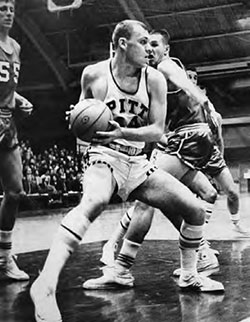 Ruby continued to enjoy success at Pitt.
Ruby continued to enjoy success at Pitt.
He played in 67 varsity games from 1962 through 1965 and scored 573 points in helping the Panthers compile a 43-30 record during that stretch. The 62-63 team posted a 19-6 record and competed in the NCAA Tournament, while the 63-64 club was 17-8 and was in the National Invitation Tournament. Ruby captained the Pitt passers as senior in 1964-65.
Among Ruby’s teammates at Pitt were Brian Generalovich of Farrell, Paul Krieger of Uniontown, Tim Grgurich of Pittsburgh Central Catholic, Dave Roman of Johnstown and Calvin Sheffield of New Brighton.
“They were very talented players,” Ruby said.
So were many of the opponents he faced.
He played against Dave Stallworth of Wichita State in the NIT at Madison Square Garden, Barry Kramer and Harold “Happy” Hairston of New York University in the NCAA Tournament, and Rick Barry of Miami twice and Cazzie Russell of Michigan in the Los Angeles Classic, and Dave Bing and Jim Boeheim of Syracuse in regular seasons games. All enjoyed successful careers in the National Basketball Association, except Boeheim, head coach at Syracuse and one of the most successful coaches in college basketball history.
Ruby was graduated from Pitt in 1965 with a Bachelor of Science degree. He completed his studies in physical therapy and received his degree in 1966 at the D.T Watson School of Physical Therapy in Sewickley and began his professional career physical therapist at Shadyside Hospital. Ensuingly, he worked as director of physical therapy services at Braddock General Hospital, Ivy Nursing Home and Magee-Women’s Hospital and Butler Memorial Hospital before returning to Shadyside Hospital as director of rehabilitation services.
He later served as vice president for services in the Mon Valley, Uniontown and Greensburg areas with Keystone Rehabilitation prior to becoming a partner with Frank Guenther at Southwest Rehabilitation Associates.
“Southwest is a Medicare certified rehabilitation agency with contracts with nursing homes and home care agencies providing physical, occupational and speech services,” Ruby said. “The agency was started by Frank Guenther and Jim Armour and I was invited to become partner when Jim left.”
Ruby retired in 2015 as a home care physical therapist and had licenses in Maryland and Delaware for Peninsula Regional Medical Center in Ocean City, Maryland. In that capacity he provided physical and occupational therapy services to patients who were unable to leave their homes.
“I enjoyed homecare because I had the opportunity to help patients regain independence in such activities of daily life as ambulation, transfer and, with an occupational therapist, dressing, bathing and cooking,” Ruby said. “We also provided adaptive equipment to help them reach their goals.”
Ruby and his wife, the former Nancy Lee Manown of Belle Vernon is a 1962 graduate of Bellmar High School, and is the daughter of Mrs. Clara Lee Nelson Manown of Lynnwood and the late Jack Manown.
The couple has three children and seven grandchildren.
“My parents set the standard for me early in life,” Daryle said. “They emphasized a strong work ethic and stressed academics before sports. I was taught to be respectful and not judgmental and that family and friends are very important in anyone’s life. I learned to respect others, help others when needed and listen when family or friends have issues that are troubling them.
“Those lessons have remained with me throughout my life.”
(Grateful acknowledgement to Ron Paglia for this biography that appeared in The Valley Independent February 14, 2014)
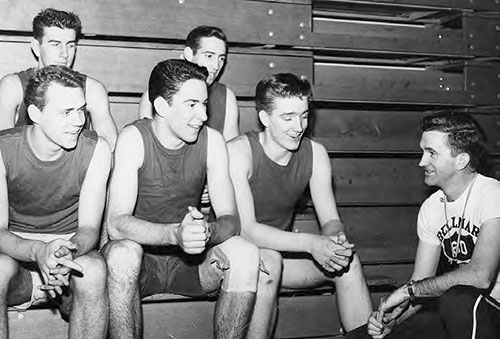
Photo with Coach Kenny Clark 1959-60 Bellmar High basketball season From left to right back row. Ron Coats, John Kasuda. Front row Daryle Ruby, Walter Lautsch and Tom Johnson.
Joe Salvino
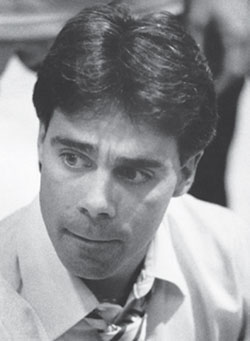
Thirty-three years ago, when Joe Salvino took over as varsity boys’ basketball coach at Monessen, not even if he had the greatest fantasies in his mind could he have imagined how that would turn out.
Salvino had just finished his first season as an assistant to new coach Craig Austin. After one campaign, Austin left for another job and the reins were turned over to Salvino.
The rest, as they say, is history.
Under Salvino’s watch, the Greyhounds made the WPIAL playoffs every single year, a mark that currently is a WPIAL record. They also won 20 section titles, six WPIAL titles and two state crowns as he has amassed an amazing record of 626-247.
In the most recent 2016-17 season, Salvino guided Monessen to a second WPIAL Class A title in three seasons and his team reached the western finals of the PIAA tournament before falling to eventual state champ Kennedy Catholic in the closest game the defending champions played in the entire playoffs.
All these years, playoff wins, titles and 1,000-point scorers later, Salvino admits he didn’t see what the future had in store for him.
“I had just finished my first year as a varsity assistant and then I got the job,” Salvino said. “I never thought I’d be here this long, but I certainly feel blessed. I’ve had great players and assistants along the way who bought into what I wanted to do.
“It shows what hard work and being a team is really about. And the community support has been amazing.”
One way Salvino pushed his teams was by scheduling the most rigorous non-section slate in the state each year. While Monessen has long been a small Class A school, enrollment-wise, the exhibition schedule always is dotted with the biggest and best schools in the WPIAL.
“To be the best, you need to play the best,” Salvino said. “I was never interested in padding our record with easy wins. I don’t care if we lost seven, eight, nine games, as long as we were tested and ready for the playoffs.
“Anyone can go 20-2 and then lose in the first round.”
And losing in the first round has been a rarity for Monessen.
One of the standing thoughts around the community is that the WPIAL and PIAA playoffs are part of the regular season schedule for the Greyhounds.
A self-described disciple of coaching legend Bobby Knight, don’t be fooled by Salvino’s diminutive size in person. He is as fiery as they come and a demanding disciplinarian.
He has beaten cancer and lived through the death of his oldest son Joe. He has learned to be his own toughest critic.
Yet, as vocal as he is with his players during practices and games, nobody loves their players more than him.
That is evident by the number of former Greyhounds who, whenever they get the chance, stop by practice, go to a game or see him in public and reminisce about their time together.
“I have been tough on the players at time, but only because I believed in their potential and I wanted them to succeed,” he said. “I never wanted any of my kids to leave the program as a senior and later wonder, ‘I wonder if I had just done this.’ I pushed them for their best, and that’s usually what I got.
“I can tell you, as a coach, it feels good in the playoffs to look in the stands and see so many of my old players there supporting. That’s tradition.”
Salvino didn’t play basketball as a student at Monessen. Too short for that game, he excelled in baseball and went on to college for that sport.
But he had a love for so many sports and as a result also had a lengthy career as an assistant football coach at Monessen and even served as head coach of the Greyhounds for two seasons.
In basketball, his illustrious career included many milestones as he eclipsed 100, 200, 300, 400, 500 and 600 win plateaus.
However, those records never meant anything to the personally-driven coach.
“To be honest, the only number that ever mattered to me was 100,” he said with a laugh. “I hated like heck to lose that 100th game. I never wanted that many losses. Wins don’t matter as long as we grow as a team.”
When asked to recall his greatest moments in a long, illustrious career, Salvino said there were too many to mention, although these undoubtedly are among the highlights:
*Winning back-to-back state titles in 1988-89;
*Coaching a WPIAL titlist that had three 1,000-point scorers on it, including Patric Greene, Jimmy Arnold and Jeff Gagatko.
*Coaching back-to-back WPIAL champions that included two 1,000-point scorers, A.J. Jackson (school all-time scoring leader) and Brandon Jackson, as well as his current top assistant coach, Ricky Tyburski.
*Guiding Monessen to the WPIAL Class AA title while “playing up” in classification with the school having one of the smallest enrollments in the WPIAL.
*The most recent team that won two titles in three years and included two 1,000-point scorers in Jaden Altomore and Justice Rice.
At age 66, he shows little signs of slowing down, but he admits to having mellowed a bit.
“I may not yell as much as I used to, but I still push the players. I still get excited about coaching and watching my teams compete,” he said. “Once that is gone, then I know it is time to walk away.”
Old habits seem to die very hard.
A retired PA Turnpike worker, Salvino and his number one fan, wife, Toni Lynn, reside in Monessen. The couple has five children, including C.J. and Brianna Salvino, Jessa, Roger and Nick Brandemarte. They also have two grandchildren, Joey Salvino and Dominic Shemansky and another little boy due in July.
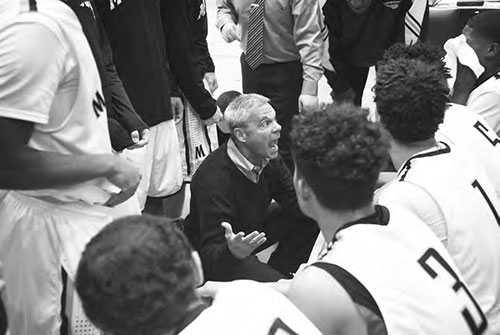
(Grateful acknowledgement to The Mon Valley Independent general manager Jeff Oliver for this exclusive biography)
Past Inductees
Read about our past Inductees here!